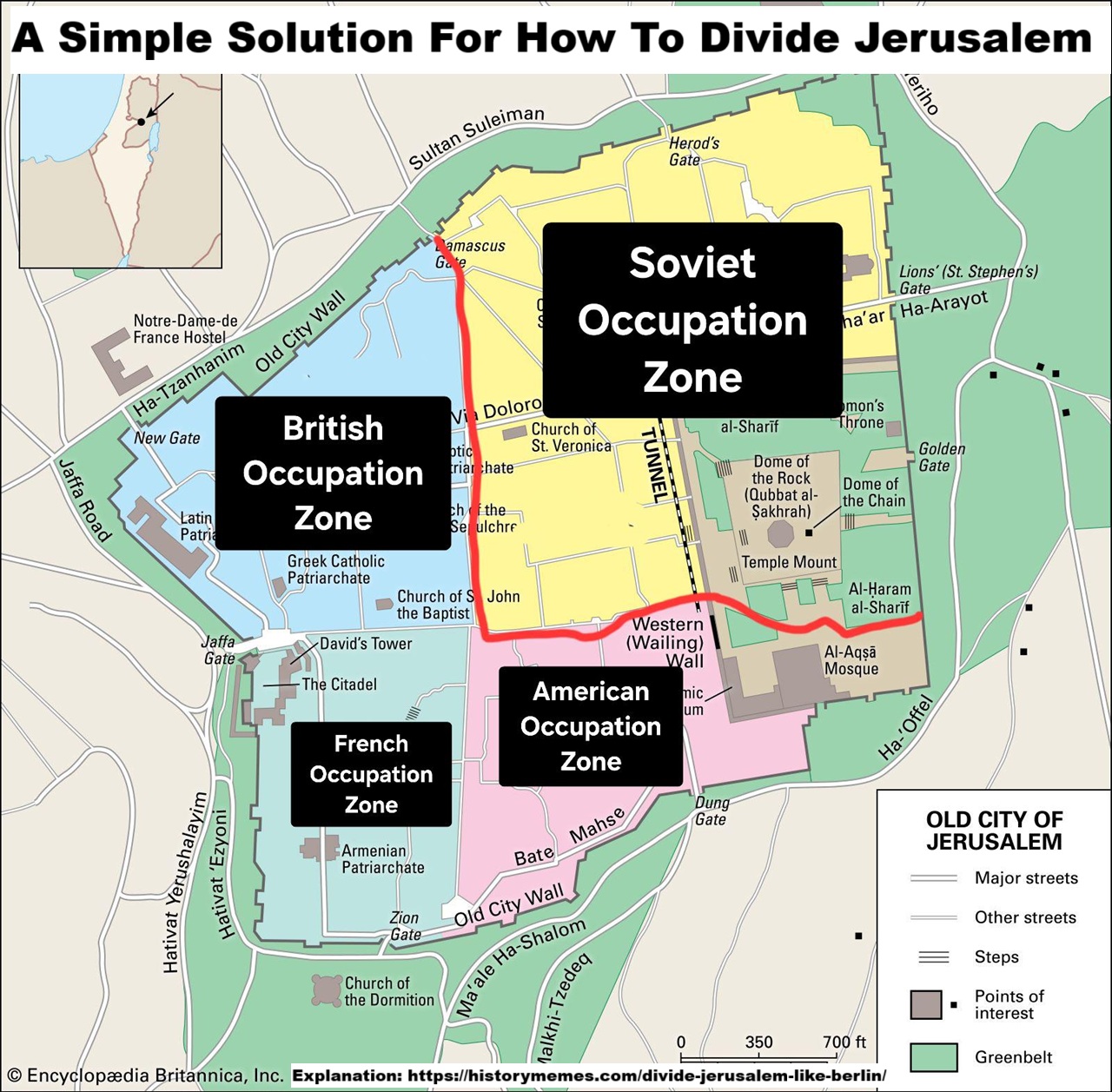
It shows the Old City of Jerusalem divided into zones of occupation by the Soviet Union, the United States, Britain, and France: just like postwar Berlin (1945–1990) was divided after World War II.
Why it’s funny:
- Historical parody:
- Berlin was famously split into four occupation zones (Soviet, American, British, French).
- This map applies the same concept to Jerusalem, which has been a city of intense international disputes, religious claims, and political tensions.
- Absurd alternate history:
- In reality, Jerusalem was never divided into Soviet, U.S., British, and French zones.
- Instead, after the 1948 Arab-Israeli War, the city was split between Israel (West Jerusalem) and Jordan (East Jerusalem, including the Old City) until 1967.
- By putting Soviet, American, British, and French occupation zones on Jerusalem, the meme imagines a bizarre “Cold War Berlin–style Jerusalem.”
- Political satire:
- It pokes fun at how Jerusalem is often described as a city carved up by different groups (Jews, Muslims, Christians, Israelis, Palestinians, etc.).
- The meme exaggerates this by overlaying the exact Cold War template of Berlin onto the Old City.
The joke in short:
This is a what-if scenario: “What if Jerusalem had been divided up after WWII the same way Berlin was?”
It’s humorous because it highlights both the real-world complexity of Jerusalem and the absurdity of Cold War-style partitions being applied somewhere else.
The Real Four Quarters of the Old City
- Muslim Quarter (largest, northeast)
- Population: Predominantly Palestinian Muslims.
- Key sites:
- Temple Mount / Haram al-Sharif – includes the Dome of the Rock and Al-Aqsa Mosque, two of the holiest sites in Islam.
- Traditional markets (souks) and residential areas.
- Historically the most populous quarter.
- Christian Quarter (northwest)
- Population: Various Christian denominations (Greek Orthodox, Roman Catholic, Armenian, Coptic, Syriac, Ethiopian).
- Key sites:
- Church of the Holy Sepulchre – believed to contain the site of Jesus’s crucifixion, burial, and resurrection, making it the holiest site in Christianity.
- Numerous monasteries, convents, and hostels for pilgrims.
- Jewish Quarter (southeast)
- Population: Primarily Jewish residents (though expelled after 1948, they returned after 1967).
- Key sites:
- Western Wall (Kotel) – the last surviving remnant of the Second Temple complex, Judaism’s holiest prayer site.
- Yeshivas (Jewish religious schools) and restored synagogues.
- Also contains archaeological remains of ancient Jerusalem.
- Armenian Quarter (southwest)
- Population: Armenian Christian community, one of the oldest continuous communities in the city.
- Key sites:
- St. James Cathedral and the Armenian Patriarchate.
- Smaller in size than the others, but maintains a distinct identity and autonomy.
Historical Context
- The division into “quarters” isn’t a strict legal or political separation, but rather a traditional and demographic one that developed over centuries under Ottoman, British, Jordanian, and Israeli rule.
- The Ottoman Empire (1517–1917) recognized these divisions.
- During the British Mandate (1917–1948), the Old City remained multi-ethnic and multifaith.
- After the 1948 Arab-Israeli War, the Old City fell under Jordanian control; Jews were expelled, synagogues destroyed, and only Muslims and Christians lived there.
- In 1967, during the Six-Day War, Israel took control of the Old City, and Jews returned to the Jewish Quarter. Today, all four quarters exist side by side under Israeli administration.
Overlapping Importance
- Judaism: Temple Mount (First & Second Temples), Western Wall.
- Christianity: Church of the Holy Sepulchre, Via Dolorosa (Jesus’s path to crucifixion).
- Islam: Haram al-Sharif, Dome of the Rock, Al-Aqsa Mosque.
That’s why Jerusalem is not only divided into quarters but also layered in meaning, with multiple religions claiming sacred spaces in close proximity.
Books on the topic:
- Jerusalem: The Spatial Politics of a Divided Metropolis
- Under Jerusalem: The Buried History of the World’s Most Contested City
- Divided Cities: Belfast, Beirut, Jerusalem, Mostar, and Nicosia
- Cold War Berlin: An Island City
Leave a Reply